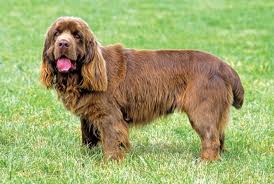The Sussex Spaniel is a breed of small, but very though and strong hunting dogs. A very rare Spaniel breed, it was developed in the last few years of the 18th century, when Mr. Fuller of Rosehill Park, Hastings, in the county of East Sussex, began the breeding process. His goal was to create a breed of barking Spaniels. During the Second World War breeding of these dogs dropped dramatically, with only 10 registered Spaniels in existence in 1947. These were the dogs saved by English breeder Joy Freer, and all modern Sussex Spaniels are descendants of those 10.

The Spaniels of Sussex have a low, long body, with a relatively massive back topped by a wide and heavy skull. Their legs are very short, their tails long in comparison to their bodies. Standing at a mere 15 to 16 inches in height (38-40 cm), they are quite heavy set dogs, weighing in at around 40 to 44 pounds (18-20 kg). Their coats are long, either slightly wavy or flat, with feathering at the neck, tail and legs. Their coats only come in one variety: a golden liver colour which is unique to the breed and a primary reason why they are the most popular spaniels in many countries.
Calm and caring, the Sussex Spaniel is pretty well suited as a companion dog. Given enough exercise they can live in an apartment or small house without any problems. They get along with other pets well, and with children even more so, being loving and gentle dogs. If the owner is sufficiently strong minded, they can also get along with other dogs well. A very firm hand is needed when raising these Spaniels, as they are bred to bark, and bark often, which can turn into a serious nuisance if not managed properly. They require firm leadership in their training, but are quick studies.
Daily exercise is necessary, as these dogs are after all hunting dogs. They must satisfy their natural instincts, preferably by playing retrieving games outdoors in the woods. At the same time, this breed is quite prone to gaining weight, and so regular walks are a must in order to prevent health issues. Other potential health problems of the breed are ear infections, intervertebral disc syndrome, and a few heart issues, none of which are major concerns, being quite rare. . The only major issue is Hip Dysplasia, which affects almost half of all the dogs of this breed.
If their ears are cleaned regularly, and they are taken to a few tests at the vet every year, they should live as much as 15 years. Whether kept as companion dogs, or used as gun dogs, these spaniels will be a loyal ally and stout friend to any family. While not quite as playful as other spaniel breeds, and exhibiting lower energy levels, the Sussex Spaniel is a rare and sought-after dog, popular for many reasons, from its unique coat colour to its gentle and kind nature.




